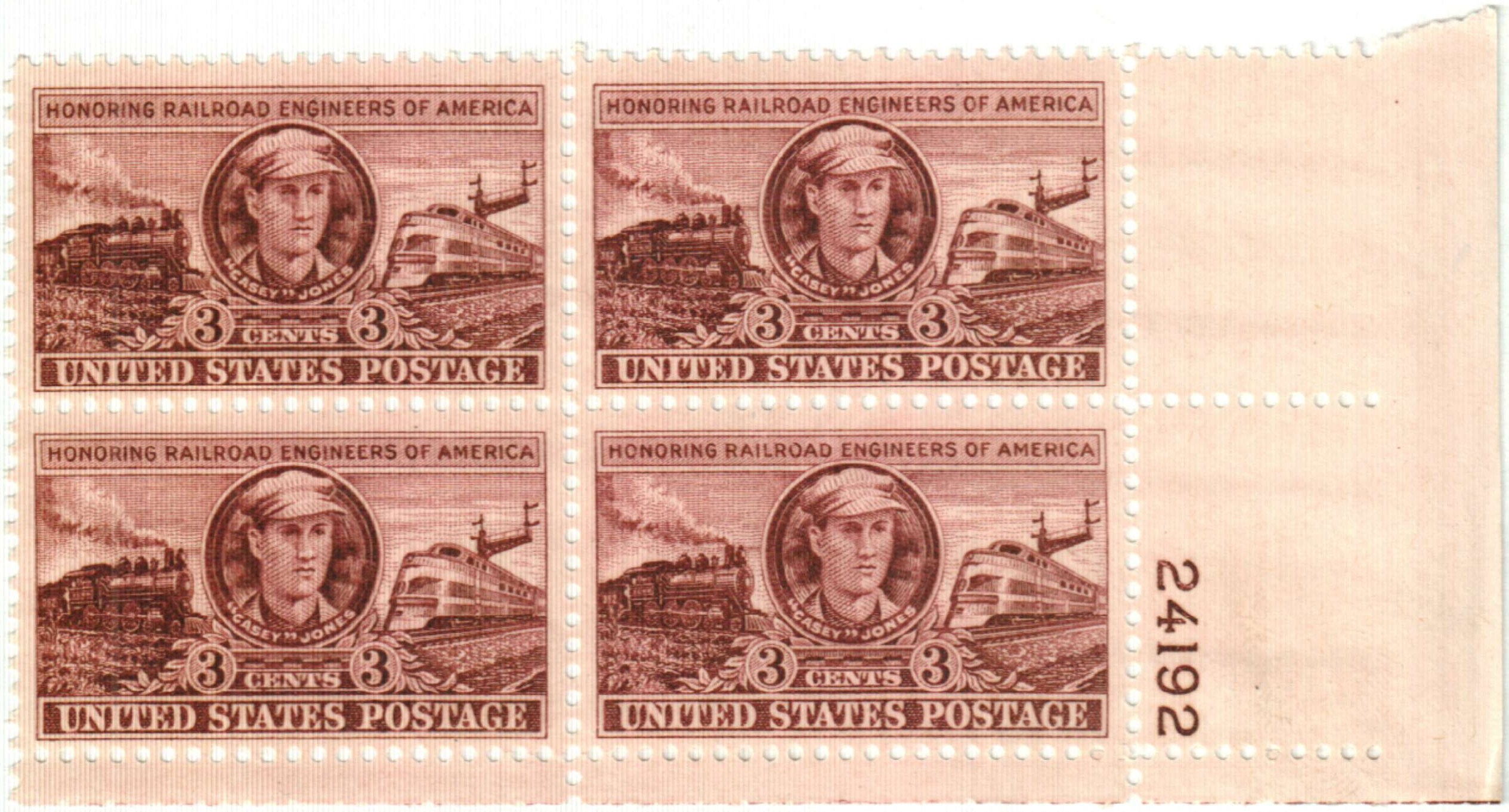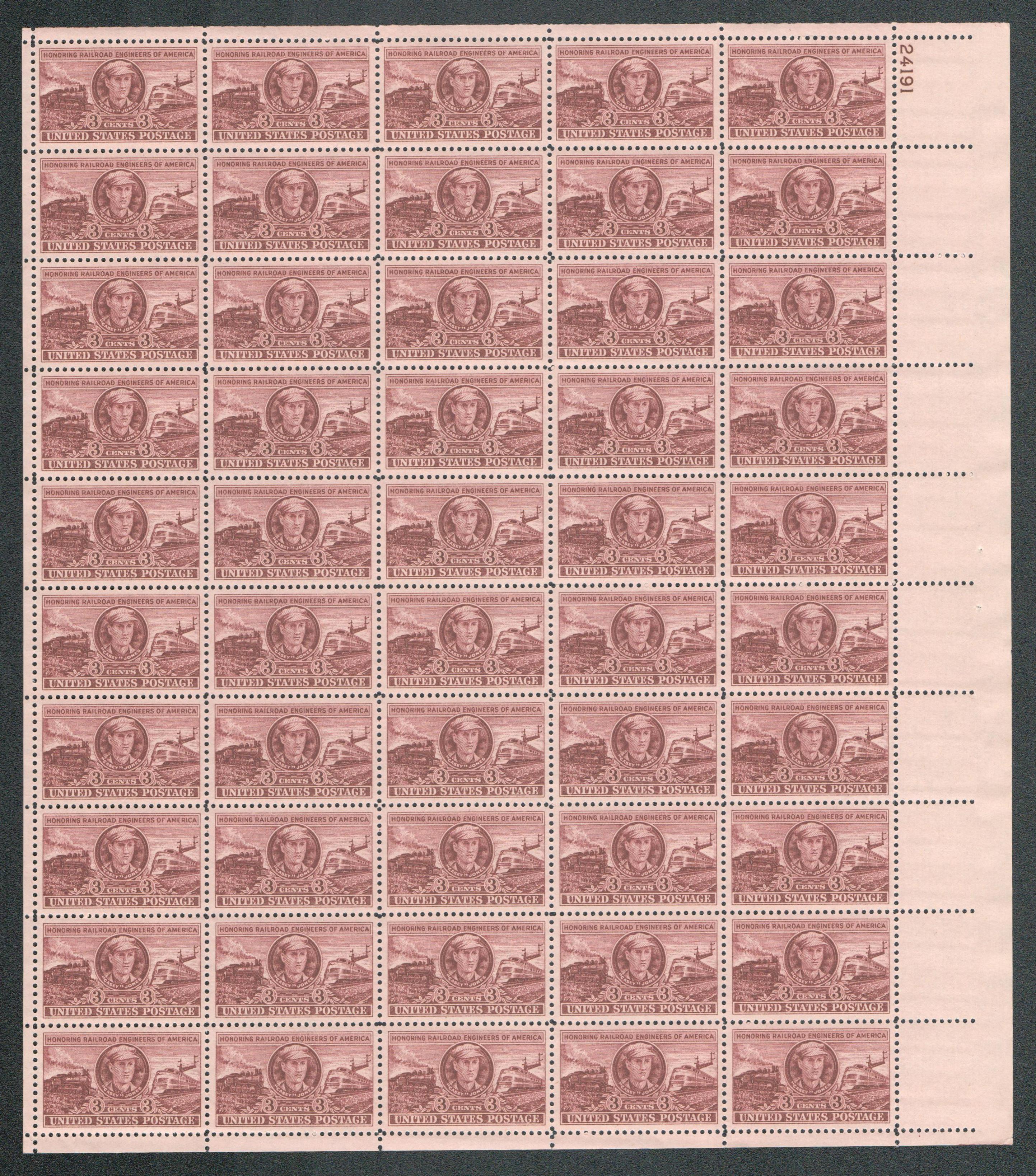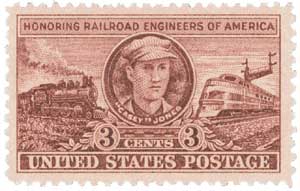
# 993 - 1950 3c Railroad Engineers of America
Birth Of Casey Jones
Jones' parents worried that the backwoods of Missouri wouldn't provide their son with enough opportunities, so they moved the family to Cayce, Kentucky. People began calling Jones Cayce, after his new hometown, and he eventually changed it to Casey.
As a boy, Jones became fascinated with trains and hoped to become an engineer one day. When he was 15, he moved to Columbus, Kentucky, and got a job as a telegrapher for the Mobile and Ohio railroad. He remained there for several years before moving to Jackson, Tennessee, in 1884 where he received a job as a flagman for the M&O. Jones did well there and quickly worked his way up the ranks. Then in 1887, a sudden yellow fever outbreak hit the crew of the Illinois Central Railroad hard and Jones was offered a job there as a fireman (tending to the steam engine's fire).

In 1891, Jones received his dream job when he was promoted to engineer. Jones quickly established a reputation as one of the country's best engineers. He had a reputation for always staying on schedule "get there on the advertised" (time) as the saying went. It's said that many people set their watches by him because he was so punctual.
Jones was also known for his unique use of a train whistle. He used a whistle made of six thin tubes that made a long note described as "sort of whippoorwill call" or "like the cry of a Viking." People that lived along his route grew accustomed to hearing his whistle and saying "There goes Casey Jones".
In 1893, Jones volunteered to spend the summer at the World's Columbian Exposition to provide passenger train service. He greatly enjoyed the experience and got to drive some newer trains, which was also very exciting for him. Two years later, Jones reportedly saved a young girl who ran in front of a train and froze on the tracks.
For most of his career, Jones had served on freight trains. But in February 1900, he was promoted to drive passenger trains, which was more prestigious and offered better pay. Jones would be serving on a so-called cannonball passenger run, so named because of the speedy service.

On the evening of April 29, 1900, Jones had completed a run to Memphis, when he volunteered to return to Canton, Mississippi, that same night to replace another engineer who was sick. As the train traveled from Memphis, Tennessee, to Vaughan, Mississippi, the main track was blocked by two freight trains, and Jones' train collided with them. Jones was able to reduce his speed from 75 miles per hour to 35, which helped prevent likely deaths among the passengers.
However, Jones lost his life in the accident. When his body was found in the wreckage, it was discovered that Jones' hand was still on the brake lever. If Jones had not stayed in the engine room to work the brake, the crash would have been much worse. His bravery has made him a folk hero, and the subject of ballads, plays, stories, and TV programs.
Birth Of Casey Jones
Jones' parents worried that the backwoods of Missouri wouldn't provide their son with enough opportunities, so they moved the family to Cayce, Kentucky. People began calling Jones Cayce, after his new hometown, and he eventually changed it to Casey.
As a boy, Jones became fascinated with trains and hoped to become an engineer one day. When he was 15, he moved to Columbus, Kentucky, and got a job as a telegrapher for the Mobile and Ohio railroad. He remained there for several years before moving to Jackson, Tennessee, in 1884 where he received a job as a flagman for the M&O. Jones did well there and quickly worked his way up the ranks. Then in 1887, a sudden yellow fever outbreak hit the crew of the Illinois Central Railroad hard and Jones was offered a job there as a fireman (tending to the steam engine's fire).

In 1891, Jones received his dream job when he was promoted to engineer. Jones quickly established a reputation as one of the country's best engineers. He had a reputation for always staying on schedule "get there on the advertised" (time) as the saying went. It's said that many people set their watches by him because he was so punctual.
Jones was also known for his unique use of a train whistle. He used a whistle made of six thin tubes that made a long note described as "sort of whippoorwill call" or "like the cry of a Viking." People that lived along his route grew accustomed to hearing his whistle and saying "There goes Casey Jones".
In 1893, Jones volunteered to spend the summer at the World's Columbian Exposition to provide passenger train service. He greatly enjoyed the experience and got to drive some newer trains, which was also very exciting for him. Two years later, Jones reportedly saved a young girl who ran in front of a train and froze on the tracks.
For most of his career, Jones had served on freight trains. But in February 1900, he was promoted to drive passenger trains, which was more prestigious and offered better pay. Jones would be serving on a so-called cannonball passenger run, so named because of the speedy service.

On the evening of April 29, 1900, Jones had completed a run to Memphis, when he volunteered to return to Canton, Mississippi, that same night to replace another engineer who was sick. As the train traveled from Memphis, Tennessee, to Vaughan, Mississippi, the main track was blocked by two freight trains, and Jones' train collided with them. Jones was able to reduce his speed from 75 miles per hour to 35, which helped prevent likely deaths among the passengers.
However, Jones lost his life in the accident. When his body was found in the wreckage, it was discovered that Jones' hand was still on the brake lever. If Jones had not stayed in the engine room to work the brake, the crash would have been much worse. His bravery has made him a folk hero, and the subject of ballads, plays, stories, and TV programs.









